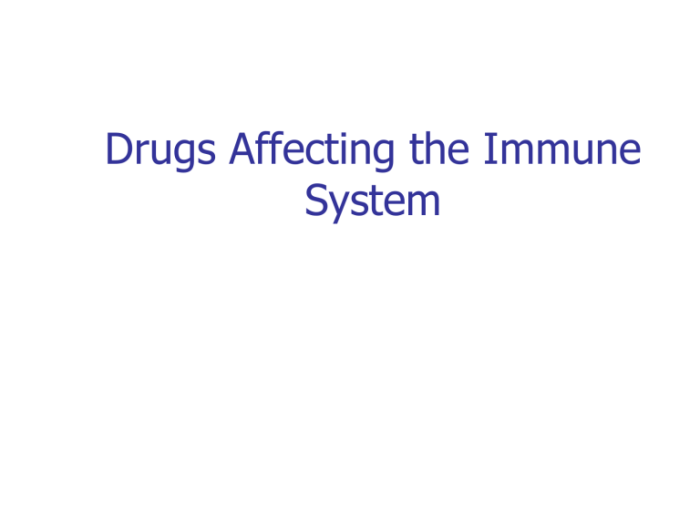Pharmacology made easy 4.0 the immune system – As Pharmacology Made Easy 4.0: The Immune System takes center stage, this opening passage beckons readers into a world crafted with meticulous care, ensuring a reading experience that is both absorbing and distinctly original. Delve into the intricate workings of the immune system, a remarkable defense mechanism that safeguards our health, with this comprehensive guide that unravels its complexities in a clear and engaging manner.
Introduction

The immune system is a complex network of cells, tissues, and organs that work together to protect the body from infection and disease. It plays a crucial role in maintaining health by recognizing and eliminating foreign invaders, such as bacteria, viruses, and parasites.
The immune system is composed of two main components: the innate immune system and the adaptive immune system. The innate immune system provides rapid, non-specific defense against pathogens, while the adaptive immune system provides specific, long-lasting immunity against specific pathogens.
The Innate Immune System: Pharmacology Made Easy 4.0 The Immune System

The innate immune system is the first line of defense against infection. It is composed of cells and molecules that are present in the body before exposure to a pathogen.
The cells of the innate immune system include neutrophils, macrophages, and natural killer cells. Neutrophils are phagocytic cells that engulf and destroy pathogens. Macrophages are also phagocytic cells that can present antigens to the adaptive immune system. Natural killer cells kill cells that are infected with viruses or that are cancerous.
The innate immune system also includes a variety of molecules that can help to protect the body from infection. These molecules include cytokines, chemokines, and antimicrobial peptides.
The Adaptive Immune System

The adaptive immune system is the second line of defense against infection. It is composed of cells and molecules that are produced in response to exposure to a pathogen.
The cells of the adaptive immune system include B cells and T cells. B cells produce antibodies, which are proteins that can bind to and neutralize pathogens. T cells kill cells that are infected with viruses or that are cancerous.
The adaptive immune system is also composed of a variety of molecules that can help to protect the body from infection. These molecules include cytokines, chemokines, and major histocompatibility complex (MHC) molecules.
The Immune Response
The immune response is a complex process that involves the interaction of the innate and adaptive immune systems. When the body is infected with a pathogen, the innate immune system responds first.
The innate immune system releases cytokines and chemokines that attract neutrophils and macrophages to the site of infection. These cells engulf and destroy the pathogen. The innate immune system also releases antimicrobial peptides that can kill the pathogen.
If the innate immune system is unable to clear the infection, the adaptive immune system is activated. The adaptive immune system produces antibodies that can bind to and neutralize the pathogen. The adaptive immune system also produces T cells that can kill cells that are infected with the virus.
Immune Disorders
Immune disorders are conditions in which the immune system malfunctions. Immune disorders can be caused by a variety of factors, including genetics, infection, and environmental toxins.
There are two main types of immune disorders: autoimmune diseases and immunodeficiencies.
- Autoimmune diseases are conditions in which the immune system attacks the body’s own tissues.
- Immunodeficiencies are conditions in which the immune system is unable to protect the body from infection.
- Monoclonal antibodies
- Immune checkpoint inhibitors
- Adoptive cell therapy
Immunotherapy

Immunotherapy is a type of treatment that uses the immune system to fight disease. Immunotherapy can be used to treat a variety of diseases, including cancer and autoimmune diseases.
There are several different types of immunotherapy, including:
Immunotherapy is a promising new treatment for a variety of diseases. However, it is important to note that immunotherapy can also have side effects. The side effects of immunotherapy can vary depending on the type of immunotherapy that is used.
FAQ Overview
What are the key components of the immune system?
The immune system comprises a network of specialized cells, tissues, and organs, including white blood cells, lymph nodes, and the spleen, which work together to defend the body against pathogens and maintain overall health.
How does the innate immune system differ from the adaptive immune system?
The innate immune system provides rapid, non-specific defense against pathogens, while the adaptive immune system mounts specific, long-lasting immunity against specific pathogens.
What is the role of cytokines and chemokines in the immune response?
Cytokines and chemokines are signaling molecules that coordinate the immune response by regulating the communication between immune cells.